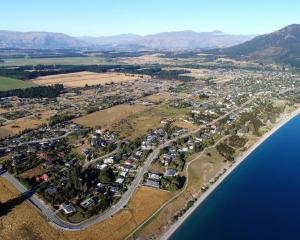
Archaeologists are spending the next month excavating parts of the historic cemetery, but already their work is proving fruitful.
Researchers began digging at the cemetery yesterday to locate unmarked graves, but they only had to scratch the surface to uncover the first find.
"What the strategy is, we use the digger to scrape off the top soil and because of differences and changes in the colour of the soil we can very quickly see where there is a grave, and so within the first 20 minutes of ... digging yesterday we found the first grave," the dig's co-director, Professor Hallie Buckley, of Otago University, said.
The first afternoon unearthed four graves.
"We've found two right up against the fence line which are outside of the current plan," she said.
"So there is a plan and the two which we found against the fence line are outside of that plan, so we've already discovered in half a day's work that what was assumed is not necessarily correct."
Drybread was a classic gold rush-era settlement at the foot of the Dunstan Mountains in the upper reaches of the Manuherikia Valley, Central Otago.

All that's left now is the graveyard, about 10km from Omakau in Central Otago.
Fifth-generation farmer Tony Glassford, whose relatives were buried at Drybread, farmed the land surrounding the cemetery and was a director of the Drybread Cemetery Trust.
"There was a fire in 1937. We were able to get physical records back, that wasn't nearly enough," he said.
As a result, the burial information was lacking and with the cemetery still in use and there were fears some planned future burial plots might already contain remains.
"We have a lot of forward-booked plots that people are unsure about if people have been buried previously, so we need to make sure we have it right. We don't want to be digging down and finding a body - that would be the worst."
Little is also known about the community which supported the early settlers.
Archaeologist Peter Petchey, co-director of the dig alongside Prof Buckley, said he hoped to uncover more information.
"Another part of the project is looking for the settlement where these people were living - where the miners came from. So I'll be heading over there and we'll be doing some work looking for that lost settlement of Drybread," he said.
He was hopeful of uncovering the settlement's remains.
"The Glassfords have a place where they have found bottles and ceramics and there's some old trees, so we know there's something there."
Once the dig is completed, research will continue in the lab for about a year.
Doctor Charlotte King would play a big role in conducting chemical analysis on the remains.
The chemistry of people's bones and teeth could uncover aspects of the deceased's past such as ethnicity, age, and sex.
A picture of their life history could then be created through evidence of diet, disease or physical trauma.
"There's a lot we can do with chemistry ... all their secrets are within their bones and teeth," Dr King said.
Once completed, the bodies would be re-interred, potentially with identification.
Otago's bioarchaeology experts have conducted similar research at cemeteries in Milton, Lawrence, and Cromwell.
The project involves locating unmarked graves, exhumation and relocation of some graves, and surveying and archaeological analysis of the site.
No marked graves will be excavated in any way.












